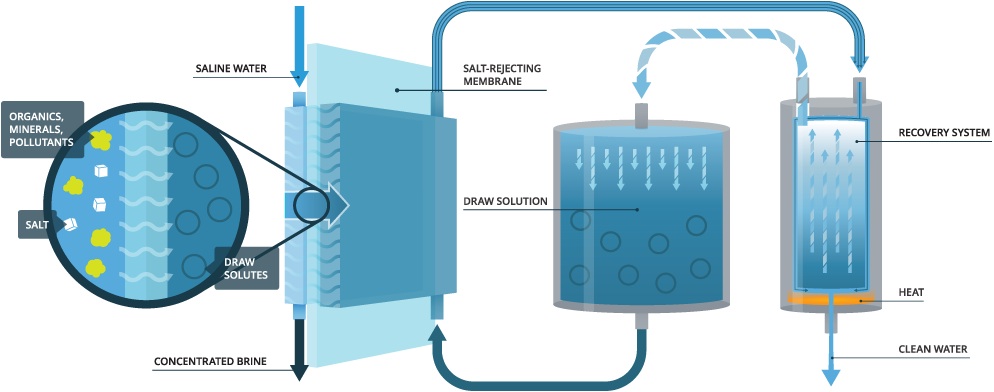Latest posts by ForwardOsmosisTech (see all)
- Nano-selective forward osmosis technology by SideStroem featured in Everything About Water - February 10, 2024
- SideStroem and Singapore Institute of Technology featured in AsianScientist - April 29, 2023
- SideStroem joins world class accelerator program - November 12, 2022
Dr. Nathan Hancock, senior director of R&D for Oasys Water, shares his thoughts on forward osmosis based systems for water treatment.
In a recent IDA YLP (International Desalination Association Young Leaders Programme) forward osmosis webinar, Oasys Water’s Nathan Hancock made a great introduction to osmotically driven membrane processes in general and Oasys Water’s membrane brine concentrator systems in particular. We at ForwardOsmosisTech appreciate Dr. Hancock’s rational and well-grounded arguments for the commercial raison d’etre of forward osmosis technologies and, in the following, list our view on the most important take-home messages from the webinar:
- The yearly number of published forward osmosis patent applications has increased exponentially from year 2000 (less than 5 publications) to the present day (350 publications expected for 2014). This reflects a growing industrial awareness of the need for improved water technologies to solve today’s water and waste water challenges.
- Forward osmosis processes allow for the decoupling of two problems that are usually dealt with in parallel at the same time, namely driving the separation of pure water from impurities in feed streams and dealing with the associated fouling and scaling issues caused by said impurities. In forward osmosis processes these problems are broken down into a two-step series. In step 1, water is extracted from feed streams into a simple electrolyte solution under low pressure & temperature conditions, which minimizes fouling and scaling. In step 2, water is separated from the electrolyte solution using various re-concentration technologies that can be leveraged to operate at maximum efficiency. This installs forward osmosis processes with operational advantages and, thus, allows FO-based systems to be utilized at a cost advantage in FO/RO hybrid systems even though the energy costs of operating the FO/RO hybrid system are implicitly higher than an RO system alone. These advantages include:
- OPEX and CAPEX savings on upstream processes such as physical and chemical pretreatment
- Lower system fouling because the water extraction takes places at benign temperatures and pressures
- Greatly enhanced ability of the hybrid system to deal with variations in feed water chemistry
- Increased operational flexibility with regards to changes in system output volumes
- RO processes are limited by the amount of hydraulic pressure that can be applied to RO membranes. The maximum pressure is typically around 70 bar, which operationally limits brine reject concentrations to 75-80000 mg/l.
- Forward osmosis draw solutions, on the other hand, can be designed to deliver up to 350 bar of osmotic pressure, enabling steady water flux across FO membrane arrays across a wide spectrum of feed stream salinities and at the same time achieve very high recoveries.
- In addition, since FO modules operate at cross-flow, a constant thermodynamic driving force can be maintained throughout the flow path in the module. This simplifies operational design of FO systems.
- For low-fouling, low salinity applications NF and RO processes are the technology of choice since they can be leveraged very efficiently. FO comes into play as an lower-energy alternative to thermally driven processes such as brine concentrators and crystallizers, in effect taking over where NF and RO technologies reach their limits. In addition, since FO concentrators do not operate at high temperatures (which otherwise put high chemical resistance requirements on traditional brine concentrators) they are less CAPEX intensive to construct. As a result, Oasys Water has directed their focus towards FO-based systems for treating high salinity feed streams – both naturally occurring (in Oil & Gas and Mining industries and industrially occurring (in Refining, Power, and other industrial segments). Said FO-based systems are also well suited to help end-users meet zero liquid discharge (ZLD) regulations.
- Forward osmosis processes are critically dependent on successfully combining 3 individual technologies, namely the FO membranes & membrane modules, the draw solution, and the draw solution recovery scheme. It’s the packaging of these 3 technologies that enables end-user problems to be solved.
- FO is still in the early days of commercialization and market adoption so there’s definitely considerable room to expand the market.
NB: Thumbnail image taken from oasyswater.com/platform


It seems most FO proponents are singing to the same repeated tune of arguments: forward osmosis based system save OPEX costs as a result of fouling reduction and higher operational flexibility.
But I’ve never actually seen real numbers documenting that the reduction in fouling and increase in operational flexibility can offset the increased CAPEX and energy costs of an FO/RO/NF hybrid system compared to a RO system with adequate pretreatment.
It makes me wonder whether FO will ever see any significant market traction.
I look forward to be convinced otherwise.
Cheers
Rick
Hi Rick
You really hit the nail on the head with that comment. One of the major barriers to market traction for FO is indeed the lack of transparent real life (and long term) operational data proving that OPEX savings in forward-osmosis based systems can offset the increased CAPEX costs.
As you are probably aware of, there are plenty of scientific articles dealing with this issue but they are – of course – not sufficient to convince industrial end users.
In conclusion, I’m afraid I’m currently not able to provide you with hard evidence proving the economical viability of FO/RO/NF hybrid systems.
My personal opinion, however, is that there are enough scientific data showing the potential of FO to reduce the overall costs of waste water treatment. This is especially the case for stand-alone FO systems designed to optimize industrial processes. In addition, given the current acceleration of commercial FO activities, I believe the hard evidence you’re looking for is just around the corner.
Cheers
Ed